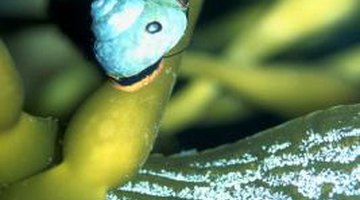How Long Is the Life of a Pond Snail?
Of the two main types of snails -- aquatic and amphibious, you probably will find the aquatic variety in your backyard pond. A type of mollusk, along with clams and oysters, an aquatic snail, or pond snail (Lymnaea spp.), is recognized by its hard shell protecting its soft, slimy body. From the tiniest dwarf pond snail to the relatively large great pond snail, the gastropod uses its two tentacles to sense its way to food and mates. It is most active during evenings and cloudy days.
Life Cycle

In its typical single year of life, a pond snail demonstrates prolific breeding capacities. Hermaphrodite by nature -- meaning both sexes can lay eggs after mating -- an individual snail can lay up to 1,000 eggs. Excreted in batches of five to 40 eggs, each jellylike egg mass is attached to an aquatic plant. Six to eight days after the eggs are laid, baby snails hatch, and they reach maturity in four to seven weeks. A pond snail overwinters by burrowing into the pond bottom, secreting a thick, protective seal over its shell's opening. The snail's predators include ducks, fish, leeches, dragonflies and beetles, which can prevent the snail from reaching its full lifespan.
Habitat
Pond snails live in most of the world’s fresh bodies of water, including streams, rivers, lakes and ponds. Many aquatic snails are found in polluted water, especially those contaminated by feces, according to an article on the World Health Organization (WHO) website. Typically dying if stranded on dry land, a pond snail can spend months burrowed into a pond bottom. When it's time for some fresh air, a pulmonate pond snail climbs onto the top of a partially submerged branch or excretes a mucus band that floats to the water’s surface and scales that band to the water’s surface, where it pushes out a type of snorkel to catch a breath; the snail also may float upside down to get air into its lungs. An operculate pond snail uses its gills to get oxygen directly from water.
Diet
Spending its life in a pond or other body of water, a pond snail doesn’t see much daylight while it creeps along the waterway's bottom slowly scouring the area for food. Its diet includes fresh plants as well as dead animal and plant matter. The snail leaves an underwater slime trail, which collects plant and animal debris as well as microscopic organisms. Upon crossing its own slime path, the pond snail eats the bits and pieces stuck to the trail. Like some birds, the snail deliberately eats sand grains to help its gizzard digest food.
Diseases
Although a pond snail might live only one year, it can have a longer lasting impact on human health. Freshwater snails of the Americas are intermediate hosts of a variety of food-borne bugs that can affect the human liver, intestines and lungs, according to WHO. They also can carry parasites. One disease, schistosomiasis, is caught through repeated contact with human feces-contaminated water inhabited by breeding snails. Although the illness can be debilitating, it is rarely fatal. So while land snails are used to make escargot, stay away from their aquatic relatives.
References
Resources
Writer Bio
Suzanna Didier's work appears in online publications including the National Geographic website, SFGate and Local.com. She is an avid cook who lives on a hobby farm, direct-markets organic produce to local restaurants and has taught at the preschool, elementary and college levels. Didier holds a Master of Arts in education from the University of Oregon.
Photo Credits
- John Foxx/Stockbyte/Getty Images
More Articles



